Abstract
OBJECTIVES--To develop a statistical model to assess the risk of early closure and restenosis on the basis of the information available at the time of stent implantation. DESIGN--An exploratory forward, stepwise multivariate logistic regression for each adverse event and multivariate polychotomous analysis for both events. SETTING--Tertiary referral centre for interventional treatment of coronary artery disease. PATIENTS--243 consecutive, successful stenting procedures between 1986 and 1993 with the Wallstent, the Palmaz-Schatz and Wiktor stents with analysis of clinical, procedural, and angiographic variables. MEAN OUTCOME MEASURES--Early closure was defined as angiographically documented stent thrombosis within the first 3 weeks after implantation and restenosis according to the 50% reference diameter reduction criterion. RESULTS--Overall early closure and restenosis rates were 14.4% (35/243) and 19.2% (40/208, for a 97% repeat angiography rate). The statistical model predicted a worse outcome for male patients, with less restenosis in female patients. The only risk factor in female patients was the presence of collaterals to the target lesion. For male patients the following risk factors for closure and restenosis were retained: multiple stent implantation during the same session, the presence of collaterals to the target lesion, stenting of the left anterior descending artery or of the left circumflex artery, and bailout stenting. Only bailout stenting implied a decreased restenosis risk. CONCLUSIONS--Clinical, procedural and angiographic variables increase the risk for early closure and restenosis after endoluminal stenting. The prediction models described above need to be validated prospectively.
Full text
PDF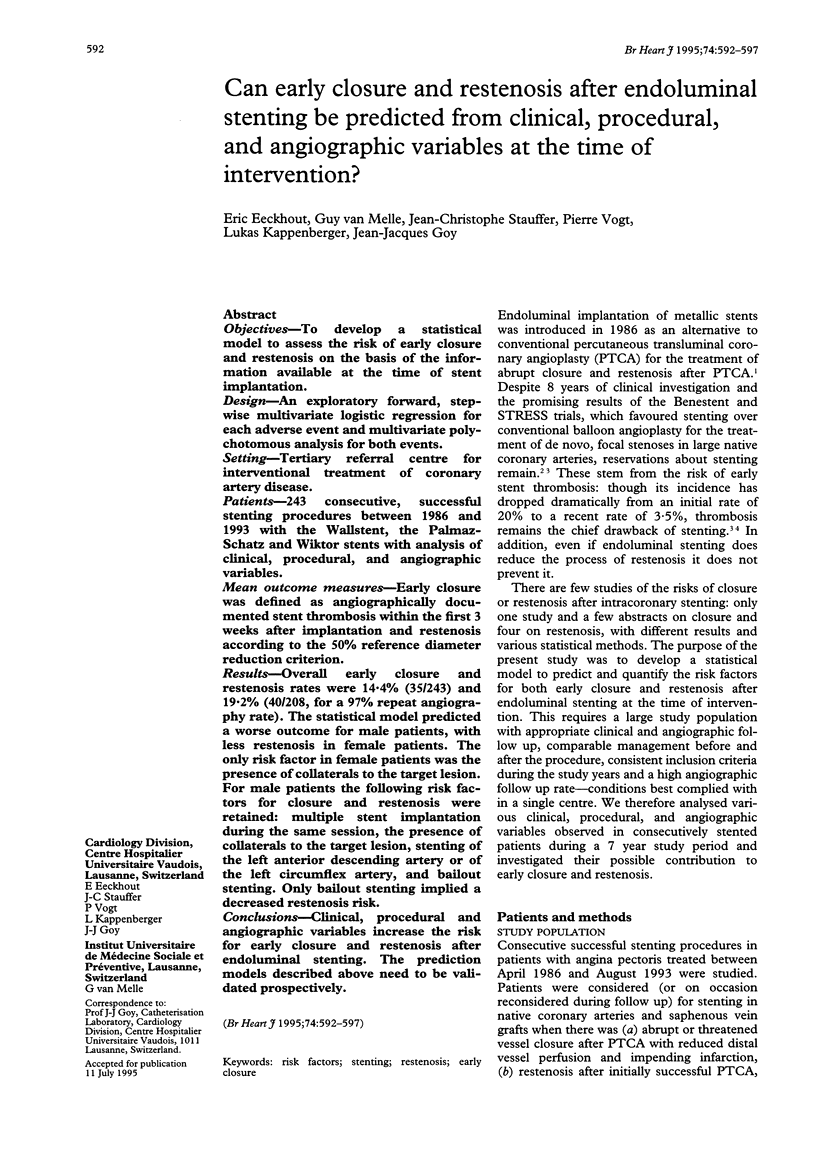
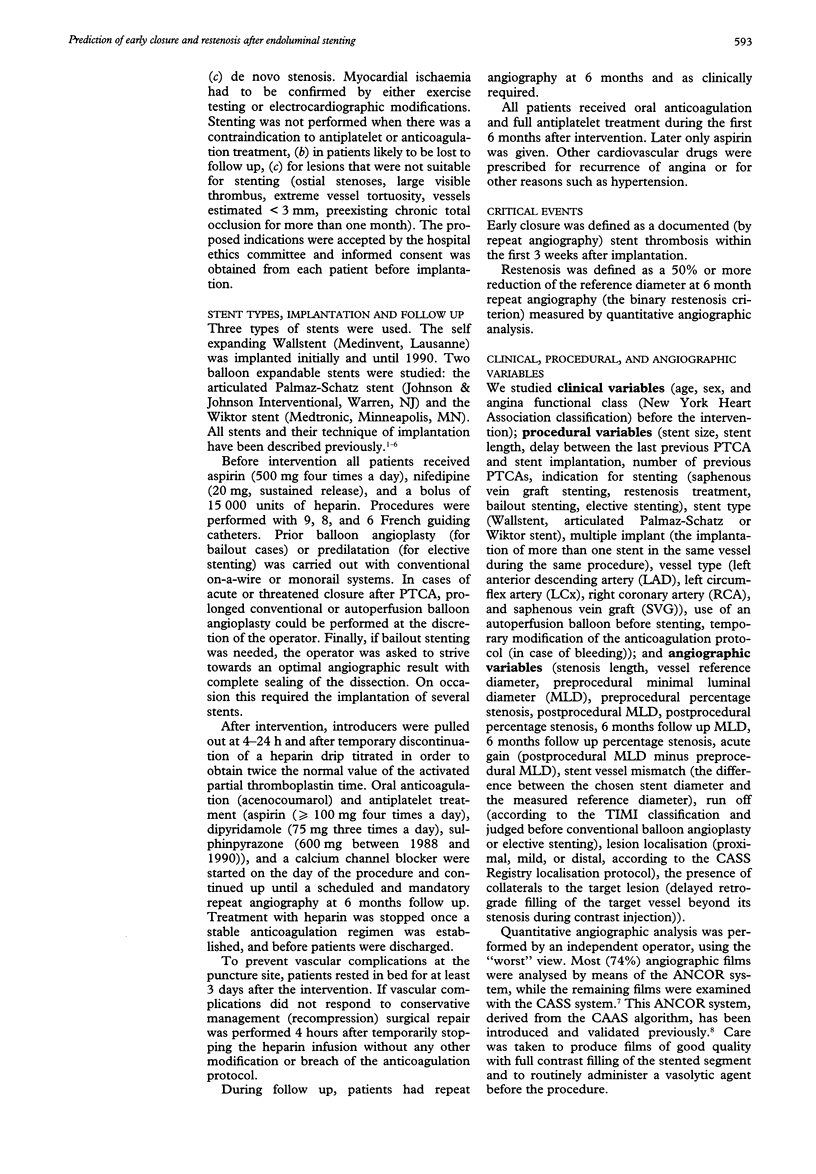
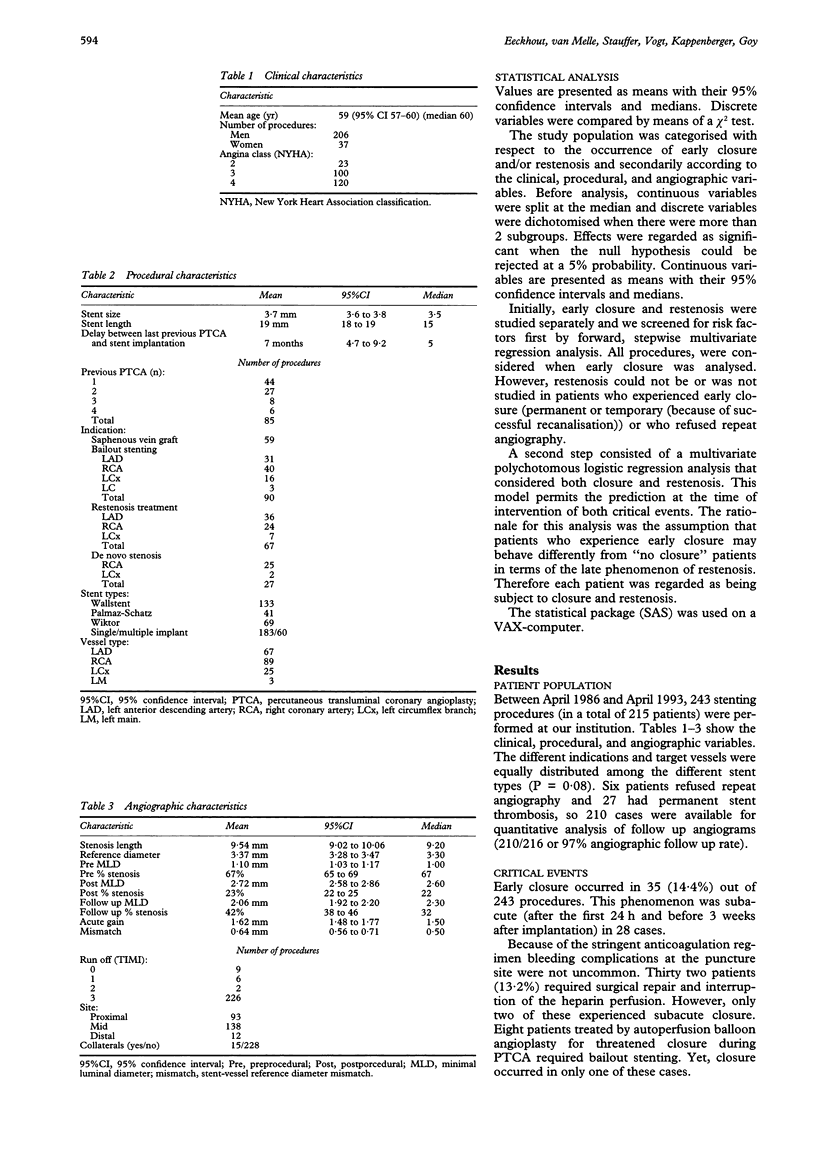
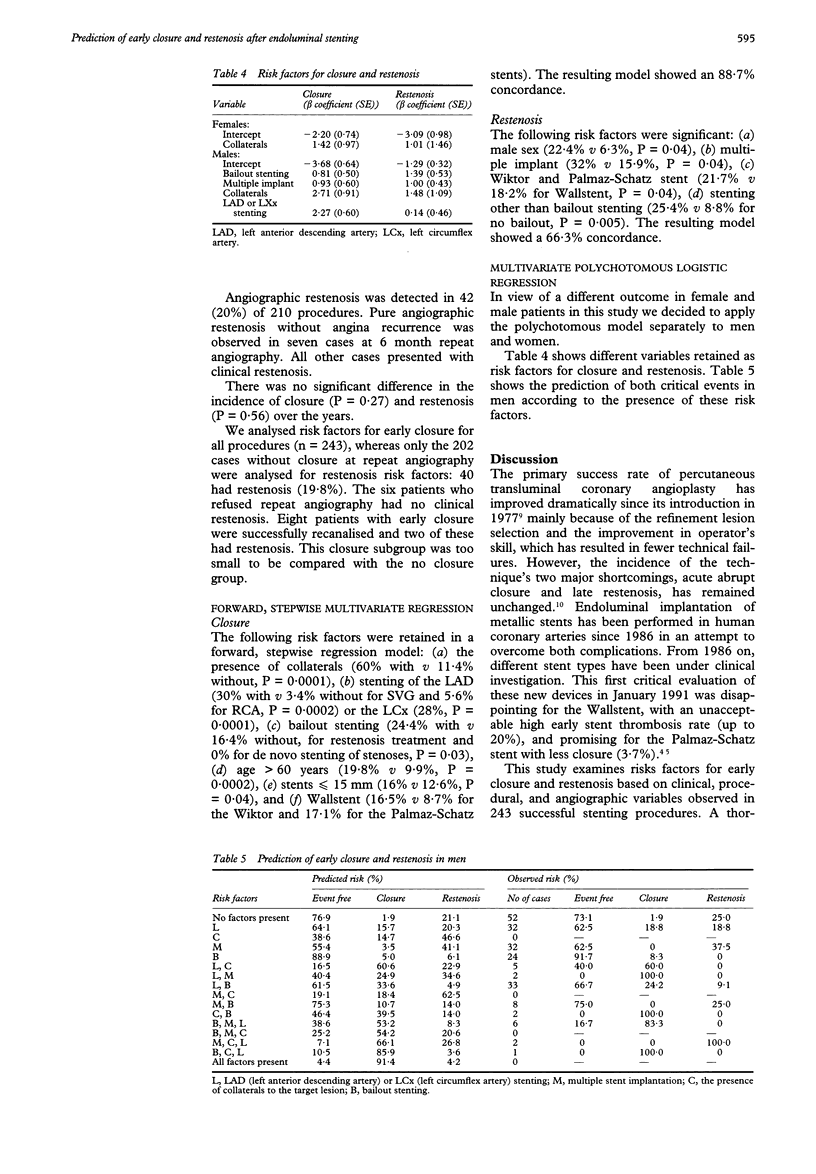
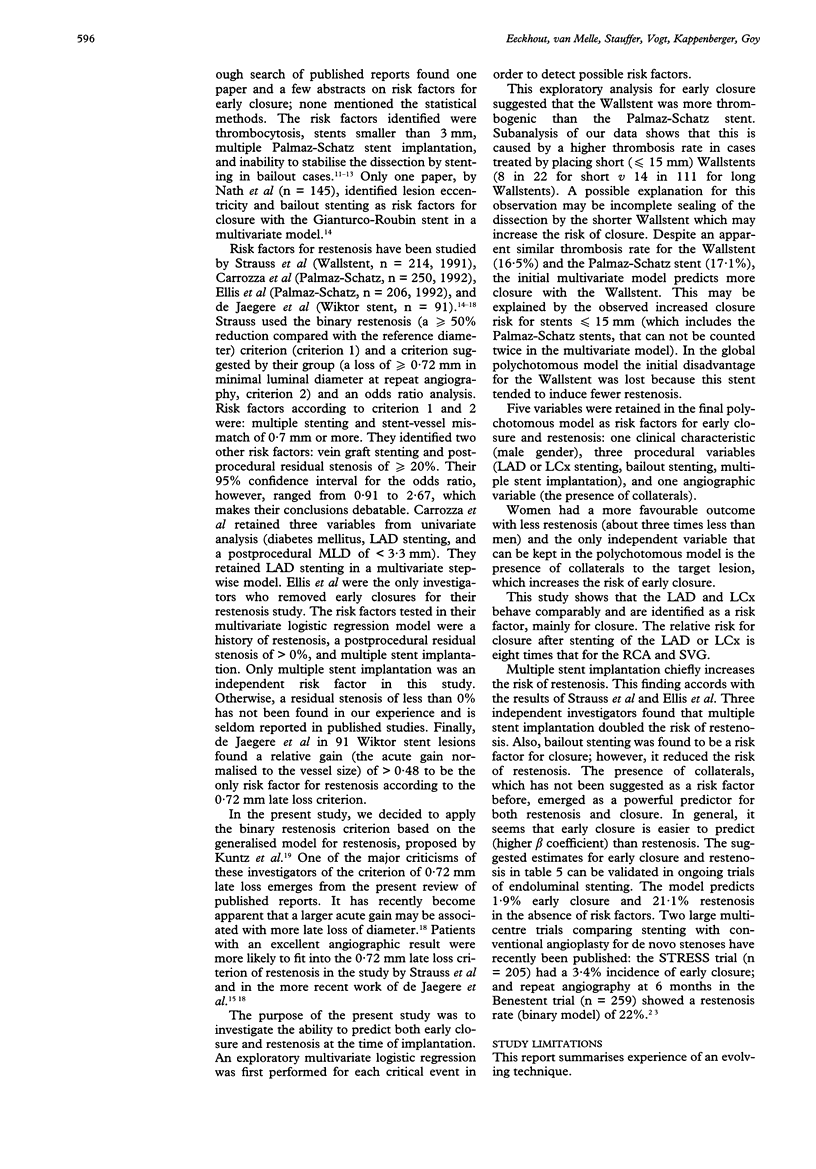
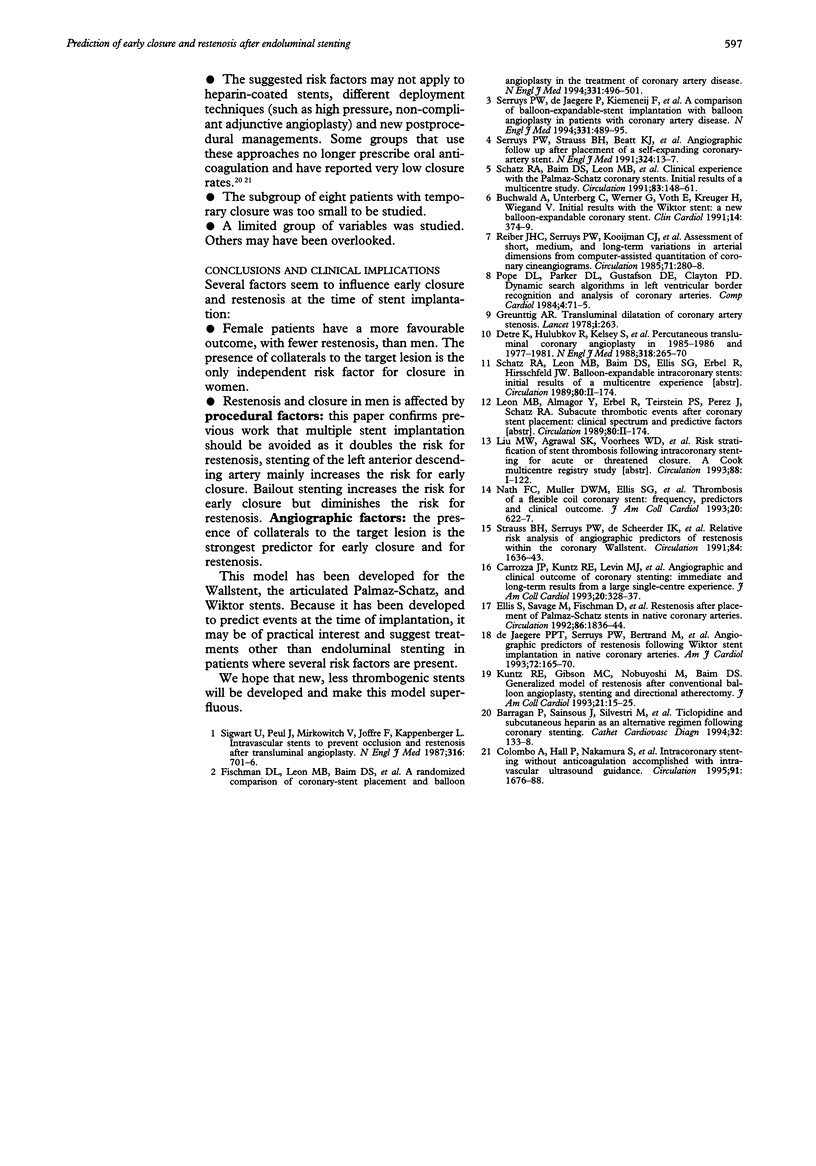
Selected References
These references are in PubMed. This may not be the complete list of references from this article.
- Barragan P., Sainsous J., Silvestri M., Bouvier J. L., Comet B., Siméoni J. B., Charmasson C., Bremondy M. Ticlopidine and subcutaneous heparin as an alternative regimen following coronary stenting. Cathet Cardiovasc Diagn. 1994 Jun;32(2):133–138. doi: 10.1002/ccd.1810320208. [DOI] [PubMed] [Google Scholar]
- Buchwald A., Unterberg C., Werner G., Voth E., Kreuzer H., Wiegand V. Initial clinical results with the Wiktor stent: a new balloon-expandable coronary stent. Clin Cardiol. 1991 May;14(5):374–379. doi: 10.1002/clc.4960140504. [DOI] [PubMed] [Google Scholar]
- Carrozza J. P., Jr, Kuntz R. E., Levine M. J., Pomerantz R. M., Fishman R. F., Mansour M., Gibson C. M., Senerchia C. C., Diver D. J., Safian R. D. Angiographic and clinical outcome of intracoronary stenting: immediate and long-term results from a large single-center experience. J Am Coll Cardiol. 1992 Aug;20(2):328–337. doi: 10.1016/0735-1097(92)90098-8. [DOI] [PubMed] [Google Scholar]
- Colombo A., Hall P., Nakamura S., Almagor Y., Maiello L., Martini G., Gaglione A., Goldberg S. L., Tobis J. M. Intracoronary stenting without anticoagulation accomplished with intravascular ultrasound guidance. Circulation. 1995 Mar 15;91(6):1676–1688. doi: 10.1161/01.cir.91.6.1676. [DOI] [PubMed] [Google Scholar]
- Ellis S. G., Savage M., Fischman D., Baim D. S., Leon M., Goldberg S., Hirshfeld J. W., Cleman M. W., Teirstein P. S., Walker C. Restenosis after placement of Palmaz-Schatz stents in native coronary arteries. Initial results of a multicenter experience. Circulation. 1992 Dec;86(6):1836–1844. doi: 10.1161/01.cir.86.6.1836. [DOI] [PubMed] [Google Scholar]
- Fischman D. L., Leon M. B., Baim D. S., Schatz R. A., Savage M. P., Penn I., Detre K., Veltri L., Ricci D., Nobuyoshi M. A randomized comparison of coronary-stent placement and balloon angioplasty in the treatment of coronary artery disease. Stent Restenosis Study Investigators. N Engl J Med. 1994 Aug 25;331(8):496–501. doi: 10.1056/NEJM199408253310802. [DOI] [PubMed] [Google Scholar]
- Gruntzig A. Transluminal dilatation of coronary-artery stenosis. Lancet. 1978 Feb 4;1(8058):263–263. doi: 10.1016/s0140-6736(78)90500-7. [DOI] [PubMed] [Google Scholar]
- Kuntz R. E., Gibson C. M., Nobuyoshi M., Baim D. S. Generalized model of restenosis after conventional balloon angioplasty, stenting and directional atherectomy. J Am Coll Cardiol. 1993 Jan;21(1):15–25. doi: 10.1016/0735-1097(93)90712-a. [DOI] [PubMed] [Google Scholar]
- Nath F. C., Muller D. W., Ellis S. G., Rosenschein U., Chapekis A., Quain L., Zimmerman C., Topol E. J. Thrombosis of a flexible coil coronary stent: frequency, predictors and clinical outcome. J Am Coll Cardiol. 1993 Mar 1;21(3):622–627. doi: 10.1016/0735-1097(93)90093-g. [DOI] [PubMed] [Google Scholar]
- Reiber J. H., Serruys P. W., Kooijman C. J., Wijns W., Slager C. J., Gerbrands J. J., Schuurbiers J. C., den Boer A., Hugenholtz P. G. Assessment of short-, medium-, and long-term variations in arterial dimensions from computer-assisted quantitation of coronary cineangiograms. Circulation. 1985 Feb;71(2):280–288. doi: 10.1161/01.cir.71.2.280. [DOI] [PubMed] [Google Scholar]
- Schatz R. A., Baim D. S., Leon M., Ellis S. G., Goldberg S., Hirshfeld J. W., Cleman M. W., Cabin H. S., Walker C., Stagg J. Clinical experience with the Palmaz-Schatz coronary stent. Initial results of a multicenter study. Circulation. 1991 Jan;83(1):148–161. doi: 10.1161/01.cir.83.1.148. [DOI] [PubMed] [Google Scholar]
- Serruys P. W., de Jaegere P., Kiemeneij F., Macaya C., Rutsch W., Heyndrickx G., Emanuelsson H., Marco J., Legrand V., Materne P. A comparison of balloon-expandable-stent implantation with balloon angioplasty in patients with coronary artery disease. Benestent Study Group. N Engl J Med. 1994 Aug 25;331(8):489–495. doi: 10.1056/NEJM199408253310801. [DOI] [PubMed] [Google Scholar]
- Sigwart U., Puel J., Mirkovitch V., Joffre F., Kappenberger L. Intravascular stents to prevent occlusion and restenosis after transluminal angioplasty. N Engl J Med. 1987 Mar 19;316(12):701–706. doi: 10.1056/NEJM198703193161201. [DOI] [PubMed] [Google Scholar]
- Strauss B. H., Serruys P. W., de Scheerder I. K., Tijssen J. G., Bertrand M. E., Puel J., Meier B., Kaufmann U., Stauffer J. C., Rickards A. F. Relative risk analysis of angiographic predictors of restenosis within the coronary Wallstent. Circulation. 1991 Oct;84(4):1636–1643. doi: 10.1161/01.cir.84.4.1636. [DOI] [PubMed] [Google Scholar]
- de Jaegere P., Serruys P. W., Bertrand M., Wiegand V., Marquis J. F., Vrolicx M., Piessens J., Valeix B., Kober G., Bonnier H. Angiographic predictors of recurrence of restenosis after Wiktor stent implantation in native coronary arteries. Am J Cardiol. 1993 Jul 15;72(2):165–170. doi: 10.1016/0002-9149(93)90154-5. [DOI] [PubMed] [Google Scholar]


